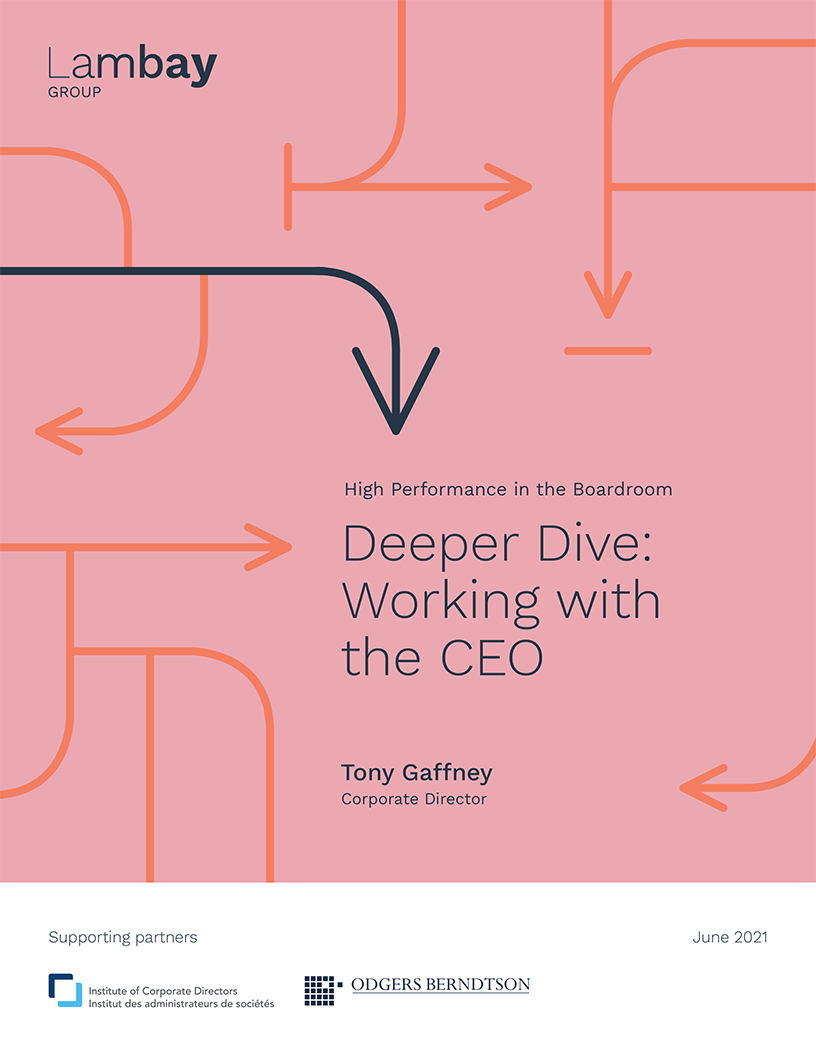
The Discussion Continues Here
The interviews for our plenary report, High Performance in the Boardroom, yielded abundant insights on topics, issues and viewpoints that our participating chairs deemed fundamental. The content was so rich there was no way we could capture it exclusively in one document.
Realizing those additional perspectives and learnings would be invaluable to help our audience probe deeper into critical areas of board, chair and director effectiveness, we created Deeper Dives. It’s a series that will expand and evolve as the dialogue launched with our initial report goes on.
In this installment, we look at the dynamics of the chair’s working relationship with the CEO and discuss strategies and tactics to help make the most of the chair-CEO partnership.
Read the Deeper Dive
Working with the CEO
As much as board chairs work constantly with their fellow directors, no single relationship is more pivotal in the governance structure than that between the chair and the CEO. The board agenda and every critical organizational decision go through both offices and are the subject of formal and informal dialogue between the two along the way. Naturally, the more frequent, more challenging or more pivotal decisions become, the more critical the relationship.
Without exception, every chair we interviewed says the foundations of a healthy chair-CEO relationship are openness, trust and mutual respect for the other’s role. “There can be no surprises,” says Bob Bell, former deputy minister of health in Ontario.
The mechanics of chair-CEO dialogue vary by circumstance and location—some have weekly in-person meetings, others regularly scheduled phone calls, with more of each on the fly as needs arise. Other dynamics of the relationship are shaped by style and personality, but most important, says Hydro One chair Tim Hodgson, is the depth of rapport.
“In a really high-functioning relationship there’s a sort of honesty, maybe at the level of humility, to say, ‘I know what I’m good at, I know what I’m not good at; you understand what you’re good at, you understand what you’re not good at. Let’s talk about it. Where have we got this and how are we going to divide the world? Where do we not have this and how are we going to supplement it?’”
Against this overall backdrop, our participants highlighted six primary elements that define the relationship and require greatest attention to ensure success.
A safe
place
Chair-CEO conversations often involve hashing out some hard business realities. But before final decisions are made, or ideas are even shared formally within an organization, the CEO needs a sounding board. Often, says Payments Canada chair Eileen Mercier, that’s the chair.
“As CEO, you’ve got to have somebody to throw ideas against the wall with,” Mercier explains. “Yes, you have your team. But that’s the second step. The first step is a safe place to say, ‘I think this is not looking good, what am I going to do about this?’ before you go to your own team and say, ‘Here’s what we’ve got to do.’”
Ironically, even though the chair (and the board) holds the power and authority to fire the CEO, he or she must also provide a forum where the CEO feels totally free to be honest with their own doubts and fears. Logistec chair James Cherry benefited from this dynamic in the 15 years he was CEO of Aéroports de Montréal. “We had absolute openness and honesty—with my chairs and my entire board, frankly,’’ he says. “I would go to the board meetings and say, ‘OK, I’m going to throw a curve at you. This is what I’m hearing, this is what I’m seeing, this is what the market is telling me. It’s not happening yet, but this is what I think is happening.’ And I was fortunate enough to have good people around the table who said, ‘OK, this is what we’re here for, let’s reflect on it.’”
“As CEO, you’ve got to have somebody to throw ideas against the wall with. Yes, you have your team, but that’s the second step. The first step is a safe place to say, ‘I think this is not looking good, what am I going to do about this?’ before you go to your own team and say, ‘Here’s what we’ve got to do.’”
Eileen Mercier
Navigating
boundaries
In our plenary report, chairs discuss how boards in the current environment are finding it necessary to push the boundaries of where their work stops, and management’s work begins—sometimes even crossing the line traditionally demarcating the two.
According to ICD chair Linda Hohol, this delicate dance can only go smoothly if there’s a good relationship between the chair and the CEO. “The chair will be vital in terms of navigating this,” she says. “It requires getting the CEO to understand we’re not here to micromanage for the sake of micromanaging. Having a chair who has a trusting, respectful relationship with the CEO is essential.”
This dynamic is nuanced and evolving, says Goldy Hyder, president and CEO of the Business Council of Canada. “Relationships between a board chair and a CEO should be based on confidence and trust and respect the distinct role each plays in furthering corporate objectives.”
Succession
planning
Few areas hinge more on a transparent relationship between the chair and the CEO than CEO succession planning. “That can often be a fraught topic,” agrees Magna chair William Young. “A transparent relationship is exceptionally useful.”
“With a brand-new CEO, it’s important to give her or him some breathing room, but make sure they understand the critical and ongoing importance of developing potential successors and that they will be evaluated on that basis,” says Bill Hatanaka, chair of Ontario Health. “Then, as it gets closer to potential succession time, the board has got to assume primacy and ask: ‘Who are your top three? Why is this? Do we need to test these people in a different pool to make sure they have resilience and ability?’”
Starting
fresh
RBC chair Kathleen Taylor is unique in that she was the first woman to chair the board of a major Canadian bank. Less unique, but still atypical, is that she started her term as chair at almost the very same time RBC appointed Dave McKay as CEO.
“People say that’s not classic best practice,” Taylor says. “Looking back on it, I think Dave and I would tell you that it has worked out very well.”
While they forged their relationship as newcomers together, in the majority of cases, there’s a point in the chair-CEO relationship where one is a newcomer and relationship-building starts anew.
If it’s the CEO who is new, Canadian Pacific chair Isabelle Courville says this gives the chair an opportunity to set roles and procedures by way of a fresh start. If the chair is new, then that chair must recognize that the incumbent CEO will likely want to maintain existing ways of operating and engagement.
“It’s more difficult when you come in as a new chair mid-term,” says Courville, “because you’re stepping in with your own view of things. It takes a bit of time. You need to strategize to do changes.”
When Young became chair in 2012, Magna CEO Donald Walker had been in the role for two years (and five years previously as co-CEO). He says there was a period of time needed for Walker to get comfortable. “I’ve been pretty clear along the way that I’ve got his back to support his best performance,” says Young. “And I think that was important.”
In-camera
anxiety
Holding meetings, or portions of meetings, in-camera may be standard board practice. At times, the CEO participates, but most board meetings also include a directors-only in-camera session. Those, says Manulife chairman John Cassaday, can unnerve some CEOs.
“In-cameras have the potential of being very destructive of board-management relationships if the board meets in-camera for two hours, comes out, the CEO asks: ‘What did you talk about?’ and the chair says, ‘Nothing.’”
To avoid this, Cassaday developed a routine to ensure transparency and diffuse suspicion. “I used to immediately debrief the CEO. But what I do now is I take 12 hours so that I can collect my thoughts and present the board’s feedback thematically—as opposed to a series of verbatims which end up just creating more division.”
Part of this process also involves summarizing for the board, before their in-camera meeting has ended, his view of the main themes that have emerged. That way, “they know the basic core messaging that’s going to go to the CEO.”
Making
a change
According to Hodgson, getting the right chemistry between a chair and a CEO is a sort of “magic.” And sometimes, it’s just not there. If that’s the case, and efforts to rekindle it fail, something may have to give.
“That’s the board’s job,” says Hodgson. “The board’s job is to say the chemistry is not there.”
If this occurs, Hodgson says the board needs to ask if the CEO is the right CEO for the business. If the answer is yes, then it needs to look at replacing the chair. Conversely, if the board isn’t happy with the CEO, then that needs to change. In either scenario, status quo is not an option. “Having a dysfunctional relationship will quickly go to a bad place.”

© 2020, Lambay Group Inc. All rights reserved.
How to cite this document
Tony Gaffney, High Performance in the Boardroom: an exclusive report on contemporary best practices of high-performing boards in a time of accelerating change. https://lambaygroup.com/report/high-performance-in-the-boardroom/
